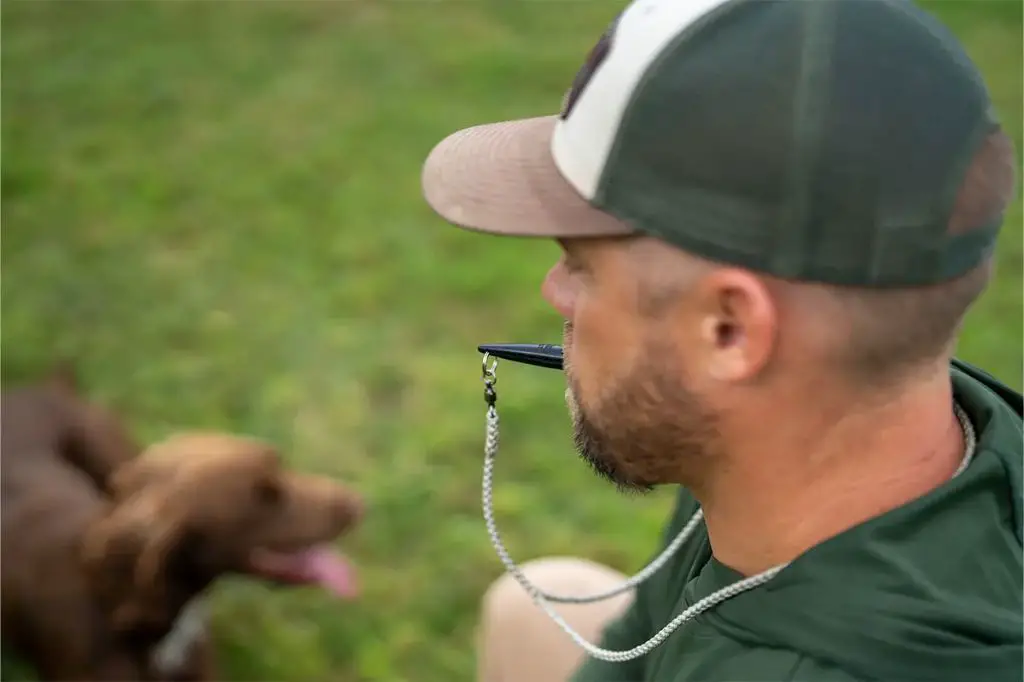Introduction
A dog whistle is a high-pitched whistle used to train dogs because the high frequency sound falls within a dog’s hearing range. Dog whistles are designed to emit a sound at a frequency between 23 and 54 kHz, which is above the range of human hearing, generally considered to be 20 kHz and below. These high-pitched whistles allow humans to give commands that only dogs can hear.
Dog whistles work by producing ultrasonic sound waves which dogs can hear but humans normally cannot. The whistle creates a very high-pitched tone that dogs’ sensitive hearing picks up. When blown properly, the whistle emits no audible sound to humans, but dogs hear it loudly and clearly. Dog whistles can be used for training purposes to get a dog’s attention, provide commands at a distance, or praise good behavior.
Sources:
https://en.wikipedia.org/wiki/Dog_whistle
https://www.akc.org/expert-advice/training/dog-whistles-training-tool-or-torture-device/
Dog Hearing Range
Dogs have a wider range of hearing compared to humans. According to LSU’s Deafness and Hearing Loss websitehttps://www.lsu.edu/deafness/HearingRange.html, the human hearing range is typically 20Hz to 20,000Hz. However, dogs can hear sounds up to 47,000 to 65,000 Hz according to the AKChttps://www.akc.org/expert-advice/lifestyle/sounds-only-dogs-can-hear/.
This means dogs can hear frequencies more than twice as high as the upper limit of human hearing. Dogs’ greatest sensitivity is in the 4-8 kHz range, while humans hear best at around 1-4 kHz. So dogs can detect very high-pitched sounds that are inaudible to humans.
Purpose of Dog Whistles
Dog whistles are often used as a training tool. The high-pitched sound emitted from a dog whistle can be heard by dogs but is usually beyond the range of human hearing. This allows the trainer to effectively communicate with the dog without shouting verbal commands. Dog whistles can be an especially useful tool when teaching commands for recall, as the whistle carries farther than a human voice.
Dog owners often use whistles when training recall. The whistle helps the owner get the dog’s attention from a distance. Once the dog associates the whistle with the “come” command, the owner can blow the whistle to call the dog back if they are roaming too far away.
Another common use of dog whistles is to deter barking. The high-pitched noise can distract dogs when they start barking excessively. However, the whistle should only be used to interrupt barking and not as a punishment. It must be paired with positive reinforcement training.
Overall, dog whistles serve as a communication tool between owners and dogs. They allow trainers to reinforce commands from a distance.
Do Dogs Dislike the Sound?
Despite the high frequency of dog whistles, dogs do not seem to find the sound aversive or bothersome. While dogs can clearly hear whistles given their hearing range, they show no signs of pain or distress when a whistle is blown properly (1). Rather than disliking the sound, many dogs are trained to respond positively to a whistle as a recall cue or as a marker during training exercises (2).

This makes sense when you consider that the sound intensity of a whistle is designed to be loud enough for a dog to hear, but not painfully loud. Responsible use of a whistle involves following manufacturer guidelines on intensity and duration of sound. As long as you use the whistle as intended, it should not be an unpleasant experience for a dog (1).
In fact, the high-pitched sound of a dog whistle may even be less irritating than human shouting or yelling for some noise-sensitive dogs. The whistle allows for a strong, clear cue without subjecting a dog to loud, sudden noises from human vocalizations (3).
So while dogs definitely perceive the sound of dog whistles, they do not seem to dislike, fear, or feel pain from the sound when whistles are used properly. The whistle simply serves as a tool for clear, long-distance communication.
(1) https://www.hillspet.com/dog-care/training/everything-about-dog-whistles
(2) https://www.quora.com/Will-using-a-dog-whistle-silence-my-neighbours-dog
(3) https://www.reddit.com/r/reactivedogs/comments/kkj9b9/do_dog_whistles_hurt_the_dogs_ears/
Using Whistles Properly
When using a dog whistle for training, it’s important to consider the frequency, volume, timing, and consistency of the whistle.
The frequency or pitch of most dog whistles is ultrasonic and above the range of human hearing, usually between 23 to 54 kHz (NYTimes). This high frequency allows the whistle to be heard clearly by dogs while not disturbing humans. Start with a lower frequency around 23 kHz when beginning training and only increase if needed.
Use the minimum volume required for your dog to hear the whistle, usually 60-80 decibels (Crafty Canine Club). Loud, shrill whistles can be unpleasant and damage hearing. Give short, clear blasts one second or less.
Timing is critical. Whistle exactly when you want your dog to perform a command, then reward with treats. Using the whistle randomly will confuse your dog.
Be consistent with one whistle sound per command. Using the same whistle repeatedly will help your dog learn commands faster.

Alternatives to Whistles
There are several effective alternatives to using a whistle for dog training and recall:
Clicker Training – Clickers provide a sharp, consistent clicking sound to mark desired behaviors precisely. The clicker’s tone is unique and catches a dog’s attention. Clicker training utilizes operant conditioning to reinforce behaviors without verbal cues. Many trainers prefer clickers over whistles since the distinct click offers clarity. [1]
Verbal Cues – Spoken commands allow communicating with more specificity than a whistle provides. For example, “sit,” “down,” and “stay” cue different desired actions. Verbal cues leverage a dog’s ability to understand words rather than just sounds. They promote better human-dog communication and understanding. [2]
Vibrating Collars – Vibration collars provide a safe, humane sensation when a button is pressed, acting as a remote cue. The buzz draws the dog’s focus while avoiding potential hearing damage from loud whistles. Vibration offers precise timing and less obtrusive signaling during outdoor activities. [3]
When to Avoid Whistles
While dog whistles can be an effective training tool when used properly, there are some situations where they should be avoided. Using a dog whistle on very young puppies or elderly dogs is not recommended, as the high-pitched noise can actually damage their hearing over time. Puppies generally cannot hear noises above 18,000-20,000 Hz until they are around 2 months old, so using a standard dog whistle on a very young puppy could be dangerous. Similarly, older dogs lose the ability to hear high frequency sounds as they age. Exposing them to loud whistles repeatedly puts them at risk for hearing loss or pain.
Additionally, dog whistles should never be used as a weapon or a means of inflicting pain on a dog. Though they were originally designed as a humane training tool, some owners unfortunately misuse whistles to try and stop unwanted behaviors by startling or hurting the dog. This type of abuse should always be avoided, as it will damage the human-animal bond and the dog’s trust. Responsible whistle training relies on positive reinforcement, not fear or pain. If there are concerns that a whistle may be used improperly or cause harm, it’s better to avoid them altogether and rely solely on verbal cues and rewards.
In summary, dog whistles can enhance training and communication when utilized correctly. But owners should exercise caution with puppies, senior dogs, and in situations where whistles may be prone to misuse. The high pitch noise should motivate a dog through positive reinforcement, never pain.

Other High-Pitched Sounds
In addition to dog whistles, there are other high-pitched sounds that dogs seem to dislike. This includes things like vacuums, blenders, blow dryers, and sirens.
Vacuums in particular produce a high-pitched motor sound that many dogs strongly dislike. The sound is very unpleasant and alarming to their sensitive ears. Most dogs will keep their distance or even leave the room when a vacuum is turned on.
Other appliances like blenders and blow dryers can produce similar high-frequency noises. Sirens also tend to be very high-pitched and irritating for dogs as well.
So while not all dogs have an adverse reaction to dog whistles specifically, they tend to dislike and avoid loud high-pitched sounds in general. Their hearing range makes certain sounds much more unpleasant for dogs compared to humans.
Theories on Disliked Sounds
There are two main theories as to why dogs may dislike or fear certain sounds:
The first is related to volume. Dogs have very sensitive hearing and loud noises can physically hurt their ears. Sounds like fireworks, gunshots, and thunder are very loud and likely uncomfortable for dogs to hear (VCA Animal Hospitals). The pain or discomfort from loud noises understandably makes dogs want to avoid them.

The second theory is association with punishment. If a dog has a negative experience while hearing a certain sound, they may come to fear the noise itself. For example, if a dog is scolded for barking and a whistle is blown at the same time, they may associate the whistle with the punishment (PetMD). The dog then dislikes the whistle noise because it predicts something unpleasant will happen.
So in summary, dogs may find sounds aversive either because the volume physically hurts their ears, or because the noise has become associated with something scary or negative through learning.
Conclusion
In summary, the ultra high-frequency sound produced by dog whistles is audible to most dogs but inaudible to humans. Though dogs can clearly hear the sound, whether they actually dislike or hate the sound is up for debate. Many dogs will respond to a dog whistle through training, but the sound itself does not appear to be inherently aversive. With proper positive reinforcement training and careful use, dog whistles can be an effective and harmless training tool. However, misuse of whistles can potentially cause stress or confusion. Overall, how a dog responds to the sound depends on factors like training, exposure, and context. Rather than making assumptions, pay attention to your individual dog’s reactions to determine their comfort level. Consider alternatives like voice commands if your dog seems bothered by whistles. When used appropriately, whistles can assist with communication, but they should not replace building a bond through positive training methods.